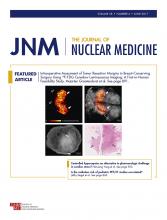TO THE EDITOR: We thank The Journal of Nuclear Medicine for asking us to write a Special Contribution article advocating rejection of the linear no-threshold (LNT) assumption in medical imaging (1). We note that all valid evidence favors either no risk or health benefit (hormesis) in the low-dose range (at least for the vast majority) and invalidates the LNT model, which wrongly asserts harm at all dose ranges.
In contrast, immediately after our article, an Invited Perspective article by Drs. Weber and Zanzonico (2) proposes an agnostic position, sometimes agreeing with us and at other times mentioning, only to dismiss, certain putatively LNT-supporting studies—most prominently, the International Agency for Research on Cancer studies using data from the International Nuclear Workers Study, which we have shown contains numerous errors (3), and an analysis in 2000 of the Life Span Study atomic bomb survivor data that we, and others, have shown to be erroneous, except for the reported possible existence of a threshold (1,4,5). In doing so, Weber and Zanzonico one-sidedly focus on risk in the low-dose region as the default assumption, neglecting benefit.
Most tellingly, they imply that prospective studies are the only valid basis on which to decide, but they simultaneously say that such studies may be “logistically and financially prohibitive,” not to mention possibly unethical. Thus, as the basis of regulatory policy and medical practice, they ensconce LNT in a position impervious to further (obtainable) evidence and implicitly reject the mounting nonprospective evidence against it.
Indeed, many, if not most, medical conclusions and practices have been arrived at without prospective studies, which would often be unethical. For example, in the 19th century a stunning insight by Dr. John Snow, that cholera was caused by sewage in the water supply, led to the purification of the water supply with salutary results. No prospective trial was ever performed, nor could it be performed ethically. Without the practical or ethical possibility of prospective studies, Bayesian estimates of probability have successfully been used to reach conclusions that have held as the best medical practices.
Moreover, many experimental and epidemiologic studies show benefit, rather than risk, from low-dose exposures (1,3). Furthermore, no ill health effects associated with natural background radiation levels have been documented anywhere in the world (5,6). The assertion of BEIR (Biological Effects of Ionizing Radiation) VII that such ecologic metastudies are meaningless puts the burden on the committee to identify confounders or other factors that can account for these consistent findings, rather than simply dismissing them a priori.
It should be noted that, whereas all medical procedures require justification and optimization, the International Commission on Radiological Protection recommendation that this apply to lowering radiation exposure (to as low as reasonably achievable) is scientifically unjustified and medically counteroptimal.
As we reported, in a recent study of young adults undergoing body CT, the observed risk of death was found to be more than an order of magnitude greater than the hypothetical LNT-predicted risk of dying from radiation-induced cancer. Underlying morbidity, rather than CT-induced cancer, is the dominant factor driving adverse outcomes. A controlled randomized trial comparing outcomes of patients who did and did not undergo CT would be the definitive prospective study to measure the benefits (versus risks) incurred by imaging. However, withholding CT for such a trial would be unethical.
Weber and Zanzonico conclude with the hopeless statement that “the debate over LNT will not be resolved anytime soon.” With agnosticism being forcefully injected into the evidential imbalance that characterizes the LNT-versus-hormesis debate, it will never be resolved. The all too common reticence to accept the available and mounting evidence that is decidedly in favor of hormesis and soundly against LNT, and the displacement of the burden of proof from the evidence-absent LNT to the evidence-rich hormesis, are unscientific, as well as assuredly unethical.
Footnotes
Published online Feb. 16, 2017.
- © 2017 by the Society of Nuclear Medicine and Molecular Imaging.







